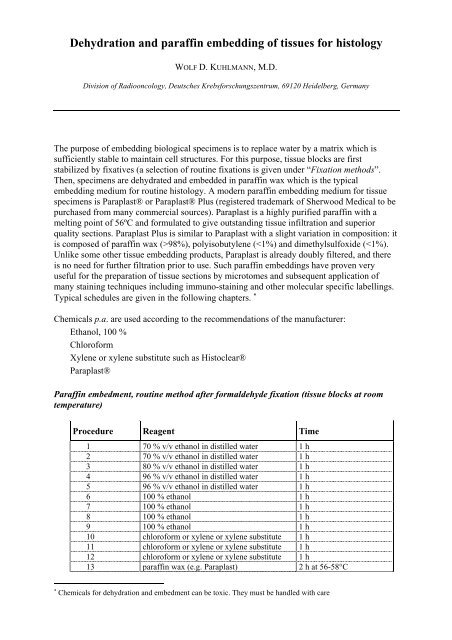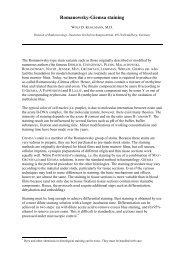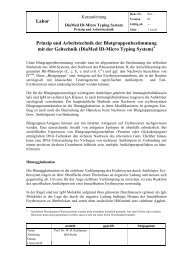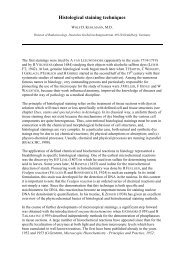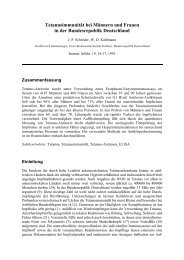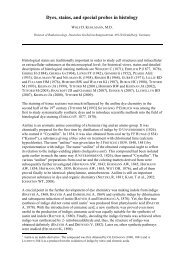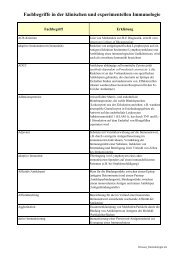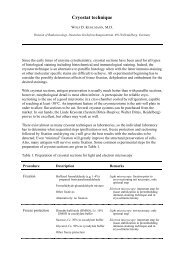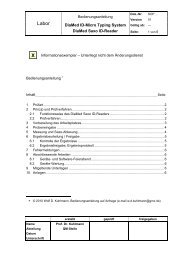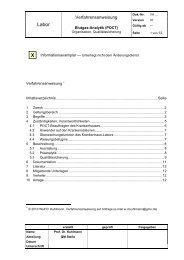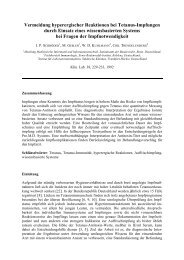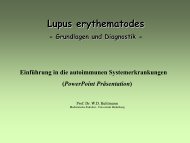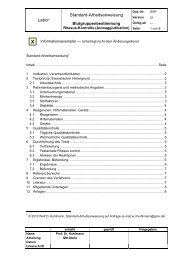Dehydration and paraffin embedding of tissues for histology
Dehydration and paraffin embedding of tissues for histology
Dehydration and paraffin embedding of tissues for histology
- No tags were found...
Create successful ePaper yourself
Turn your PDF publications into a flip-book with our unique Google optimized e-Paper software.
<strong>Dehydration</strong> <strong>and</strong> <strong>paraffin</strong> <strong>embedding</strong> <strong>of</strong> <strong>tissues</strong> <strong>for</strong> <strong>histology</strong><br />
WOLF D. KUHLMANN, M.D.<br />
Division <strong>of</strong> Radiooncology, Deutsches Krebs<strong>for</strong>schungszentrum, 69120 Heidelberg, Germany<br />
The purpose <strong>of</strong> <strong>embedding</strong> biological specimens is to replace water by a matrix which is<br />
sufficiently stable to maintain cell structures. For this purpose, tissue blocks are first<br />
stabilized by fixatives (a selection <strong>of</strong> routine fixations is given under “Fixation methods”.<br />
Then, specimens are dehydrated <strong>and</strong> embedded in <strong>paraffin</strong> wax which is the typical<br />
<strong>embedding</strong> medium <strong>for</strong> routine <strong>histology</strong>. A modern <strong>paraffin</strong> <strong>embedding</strong> medium <strong>for</strong> tissue<br />
specimens is Paraplast® or Paraplast® Plus (registered trademark <strong>of</strong> Sherwood Medical to be<br />
purchased from many commercial sources). Paraplast is a highly purified <strong>paraffin</strong> with a<br />
melting point <strong>of</strong> 56ºC <strong>and</strong> <strong>for</strong>mulated to give outst<strong>and</strong>ing tissue infiltration <strong>and</strong> superior<br />
quality sections. Paraplast Plus is similar to Paraplast with a slight variation in composition: it<br />
is composed <strong>of</strong> <strong>paraffin</strong> wax (>98%), polyisobutylene (
14 <strong>paraffin</strong> wax (e.g. Paraplast) 2 h at 56-58°C<br />
15 (vacuum) <strong>paraffin</strong> wax (e.g. Paraplast) 2 h at 56-58°C<br />
16 embedment: <strong>tissues</strong> are transferred into<br />
appropriate molds at 58°C; block-out when<br />
cooled down<br />
-<br />
Paraffin embedment, method after ethanol-acetic acid fixation(96-99% ethanol-1% acetic<br />
acid at 0-4°C, tissue slices ca. 0.5 cm thick)<br />
Procedure Reagent Time<br />
1 100 % ethanol 20 min at 0-4°C<br />
2 100 % ethanol 20 min at 0-4°C<br />
3 100 % ethanol 60 min at room temperature<br />
4 100 % ethanol 60 min at room temperature<br />
5 100 % ethanol 60 min at room temperature<br />
6 chlor<strong>of</strong>orm or xylene or xylene substitute 60 min at room temperature<br />
7 chlor<strong>of</strong>orm or xylene or xylene substitute 60 min at room temperature<br />
8 chlor<strong>of</strong>orm or xylene or xylene substitute 60 min at room temperature<br />
9 <strong>paraffin</strong> wax (e.g. Paraplast) 90 min at 56-58°C<br />
10 <strong>paraffin</strong> wax (e.g. Paraplast) 90 min at 56-58°C<br />
11 (vacuum) <strong>paraffin</strong> wax (e.g. Paraplast) 120 min at 56-58°C<br />
12 embedment: tissue are transferred into<br />
appropriate molds at 58°C; block-out when<br />
cooled down<br />
-<br />
References <strong>for</strong> further readings<br />
Romeis B (1968)<br />
Bancr<strong>of</strong>t JD et al. (1994)<br />
Bancr<strong>of</strong>t JD <strong>and</strong> Gamble M (2007)<br />
© Pr<strong>of</strong>. Dr. Wolf D. Kuhlmann, Heidelberg 08.10.2007


